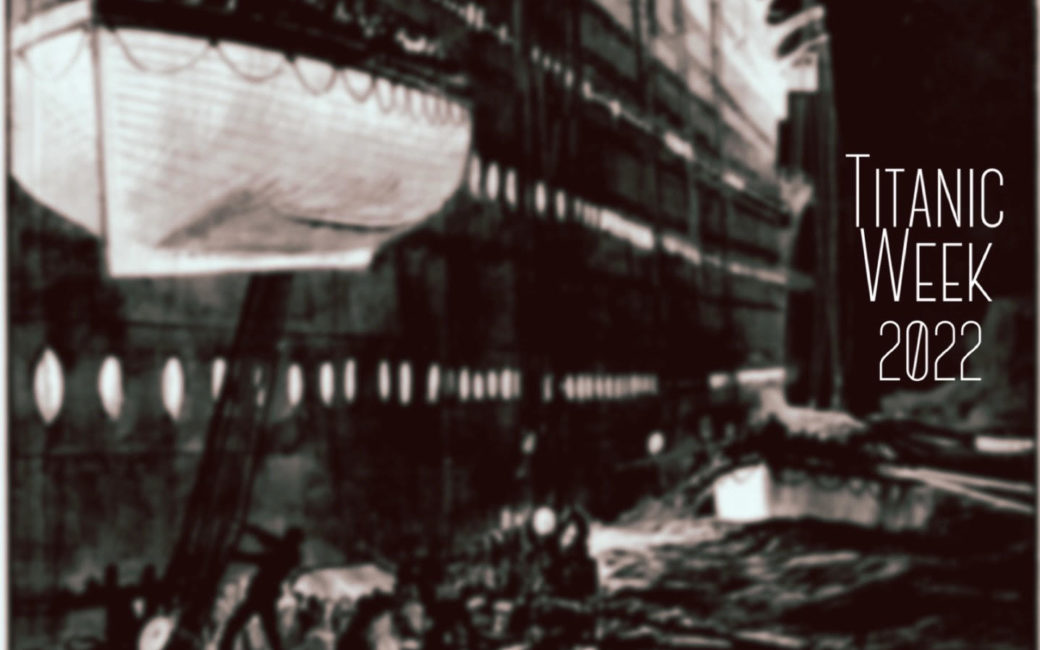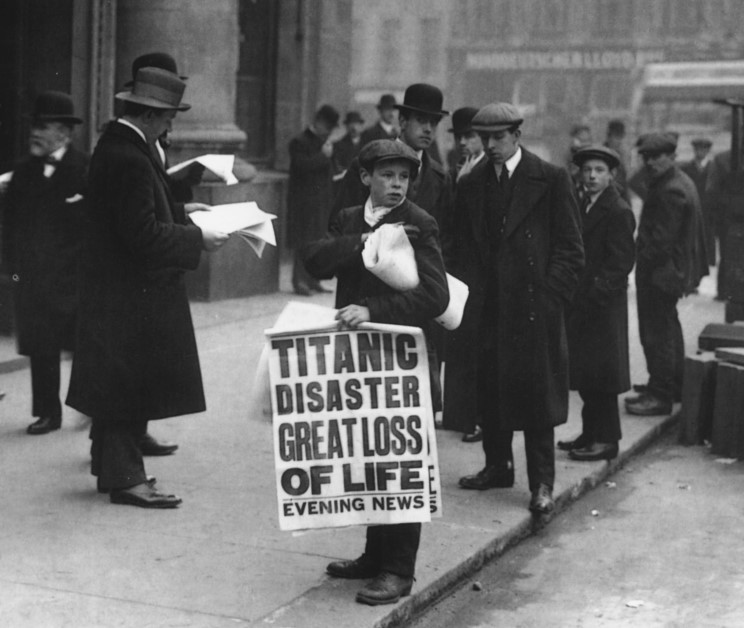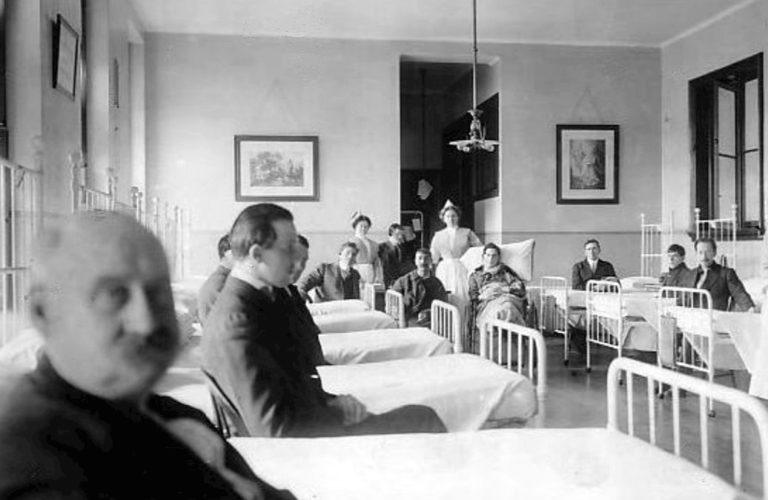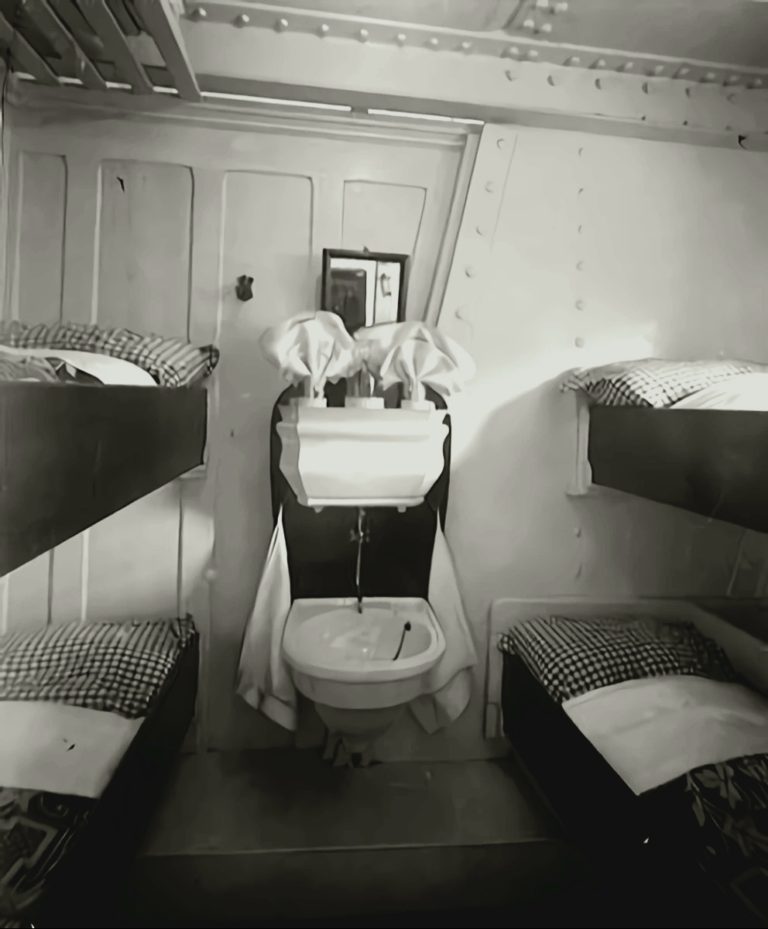"Look Here, You Crazy Thing": Edith Rosenbaum Russell
When Edith Rosenbaum boarded Titanic as a First-Class passenger at Cherbourg, she brought pretty much her life on board with her in her trunks.
And much of it was what one would typically expect of a young woman working in the fashion industry: lovely dresses and fine jewelry.

Edith Russell, photographed by Henri Manuel.
But one item was out of the ordinary: a musical toy pig.
Edith, who had been born in Cincinnati, had spent the previous four years living in Paris for haute couture.
Her little toy pig was papier-mache and spotted, wrapped in black and white fur. Upon winding its corkscrew tail, it played the song “La Maxixe.”
It was, as she called it, a mascot. Her mother had given it to her in 1911, after Edith had been in a nearly fatal auto accident. Her fiance, Ludwig Loewe, had been killed.
But Edith had survived, with only a concussion to recover from. And so her mother gifted her with the pig, a traditional symbol of good luck in France, as a charm. Edith promised her mother that she would keep it nearby always.
My mother gave me this pig as a mascot a year earlier. I'd been in tornadoes and fires and floods. I was always in trouble. Then I was in a motoring accident, and was thrown into the tyre on the back of the car. I rolled clear as it crashed into a tree. Everyone else was killed but me.
"My mother brought me this pig and said "Look here, you crazy thing, I'm giving you a mascot.
"Promise me you'll have it with you always."
Edith had originally booked passage on the George Washington, which was set to depart on April 7th, as she was keen to arrive in New York. But her editor wired that she was needed to cover the Paris-Roubaix races. Edith consequently bumped her passage out to April 10, and exchanged her ticket for one on Titanic.

Movie star Gene Gauntier with luggage, circa 1912.
Later, Edith would say that she should have known better because a fortune teller had warned her. Per an account of her experience that she wrote in 1934:
Were I of a superstitious nature, or given to following my instincts which are very strong, I should never have taken my trip on the Titanic, leaving Cherbourg for New York on April 10, 1912. In the month of January, when in Biskra, Africa, an Arab fortune-teller predicting my fortunes in the sand, held up his hands in amazement saying, ‘Madame will be in a very grave accident at sea.’ I naturally discredited this, but for months afterward felt an impeding sense of calamity…
Arriving in Cherbourg, my premonition of ill was so strong, that again I was tempted not to take the trip, and even telegraphed my secretary, expressing my fears.
On board, Edith Rosenbaum found her First-Class suite on A Deck. It is rumored that she had also booked a secondary cabin on E Deck to accommodate her 19 trunks.
Edith claimed that she had inquired about luggage insurance with a man named Nicholas prior to boarding at Cherbourg, but she had been assured that it was an unnecessary precaution because Titanic was “unsinkable.”
Edith stated that she spent the majority of the trip doing the usual things for a First-Class girl.
The first few days of the trip were uneventful, marked by the usual making of acquaintances, promenades on deck, dinners in the Ritz, tea in the Winter Gardens, etc. As a matter of fact, it was only by looking out at sea; that one realized that one was on the ocean.
Edith recalled that the day of April 14 was “brilliantly fine, but icily cold.” She figured that the only warm place in the whole boat was her bed, so that is where she elected to stay until about 4 o’clock in the evening. “If you were to go inside of your Frigidaire, or hold your hand over a solid block of ice,” Edith wrote, “you would get an idea of the temperature. The cold cramped one’s face and hands.”
After a gala dinner, Edith returned to her stateroom. After turning in, she heard a calamity below-deck and looked out her window to see a “white mass” moving by, into the distance.
Edith put on her fur coat and popped into a friend’s room to suggest they go up to boat deck. Edith said the few people there were in “various stages of undress.” Someone pointed out a nearby iceberg.
Frankly, I was overjoyed. I had always wanted to see an iceberg, from the time of my geographical school days; not realizing the danger of the encounter. I remember one man commenting that if icebergs were supposed to be two-thirds below water, and one- third above, ‘this must be a corker.’ We all regarded it as a joke, and ran to the forward part of the deck, picking up bits of ice scattered about. Someone suggested a snow-ball fight.
An unspecified officer advised the party that they had struck an iceberg but all was perfectly fine and they should get back to bed. Edith said she had returned to her room and was undressing when a steward knocked on her door and told her that all passengers had been instructed to put on lifebelts.
Edith hastily put on a dress and her fur coat, grabbing anything to hand that she could think of. And then, for reasons even she never fully understood, she locked her trunks and tidied her room.
I was met by my room steward, Wareham, fully dressed in overcoat and derby hat. I asked, ‘Wareham, do you think there is any danger, or is it simply the rule that all passengers should put on life belts?’ He answered, ‘It is a rule of the Board of Trade that all passengers must put on life belts and that women and children are put aboard the lifeboats. Now I do not think that the boat can sink. In all probabilities we shall tow her on to Halifax.’ So I said, ‘If you have any idea of going to Halifax, here are my trunk keys, and you better clear my trunks at the customs.’ I remember now, but did not at the time appreciate the significance of his reply, ‘Well, if I were you, I would kiss those trunks good-bye.’
Edith left her room soon thereafter.
I shall always remember the last view of my stateroom – the rosy, soft light of the table lamp, the red reflection of the radiator. Everything so cozy and still: I little thought it was my last look.
On her way out, Edith asked Wareham to go back to her suite for her beloved mascot, which he did gladly. According to her account titled, "I Survived the Titanic," the exchange went something like that. "I said, “Well, don’t you think it would be a good thing for me to keep my mascot with me?” He said, “Yes, it would be rather a good thing.”
She said that as Wareham proceeded down the corridor, she recalled saying that the ship was distinctly aslant.
On her way to the First-Class Lounge, Edith stopped into the quarters of her friend, Robert Daniel, who is noted in Titanic history for bringing with him the most expensive dog on the ship, a French bulldog named Gamin de Pycombe.
Edith recalled, “It was whining and crying. I remember taking it and tucking it under the bed covers, and patting its head.” Edith and Mr. Daniel then carried on to A Deck.
But the dreaded cold and lack of order led Edith to take to an armchair in the First-Class Lounge. She stayed there until she caught the eyes of Bruce Ismay, who was—by Edith’s account and others’ as well—pretty much frantic.
I then went out up to the Boat Deck and found myself standing next to Mr. Bruce Ismay, the Managing Director of the White Star Line, who was wearing his black evening trousers and a nightshirt with frills down the front. He was shouting orders/ A number of men on the other side of him were banked up almost in a solid mass near the cabin bulkhead. He spied me and called out: "What are you doing on this ship? I thought all women and children had left! If there are any more women and children on this ship, let them step forward and come over to this stairways immediately."
Mr.Ismay practically threw me down a narrow iron stairway to the deck below. There has been much criticism of Mr. Ismay, but he certainly saved my life. I passed between two lines of sailors to the rail. Two burly sailors got hold of me and attempted to throw me head foremost into the lifeboat which was suspended alongside. But when I noticed how far from the rail that lifeboat was, swinging on its davits from above, I became terrified -- so much so that my legs and feet went rigid and my slippers fell off. I screamed to the two men: "Don't push me!" One replied, "If you don't want to go, stay!"
Edith guessed she spent the next five minutes searching for her slippers.
One of the crew then grabbed the toy pig from Edith's arms and told her that at least they’d save her “baby.”
And because Edith had promised her mother that wherever she would go, the mascot would go, she—with the assistance of a nearby gentleman who offered to lift her over the side—got into the lifeboat. She found her pig as the boat was being lowered away.
It was Lifeboat 11, which was one of the few to exceed capacity. Edith, seeing the young children wriggling and crying. And so she played the song on her toy pig.
Edith later credited the bravery of many, especially Bruce Ismay—surely some of the only praise he received in the wake pf the disaster. “What thrilling deeds of heroism! Bruce Ismay certainly saved my life, and I don’t doubt that he saved many more."
On board Carpathia, Edith set out to send a telegram to mother that began with “Lost all.” But she took in the decks of the Carpathia, crowded with widows and orphans and the bereaved, and crossed it out. Instead, she wrote, “Safe. Carpathia. Notify Mother.” In 1934, she wrote, “My losses were only material, while there were so many who lost those whom they loved.”
“I survived Titanic,” Edith once said. “But I never really escaped it.”
Edith Rosenbaum went on to become one of the first, if not the first, female correspondent to enter the trenches with soldiers during the First World War by signing on as a journalist with the American Red Cross. In 1920, she changed her surname to Russell due to anti-German sentiments.
She died in 1975 at the age of 95.
In 2001, during a James Cameron expedition to the Titanic wreck, Edith’s stateroom was found and explored. The dressing table was still upright, with its mirror still intact.
SOURCE MATERIAL
“Gilded Lives, Fated Voyage,” by Hugh Brewster. 2012.
https://www.encyclopedia-
https://charlespellegrino.com/
http://www.paullee.com/
https://www.encyclopedia-titanica.org/edith-russell-saved-from-ocean-by-toy-stuffed-pig.html

































